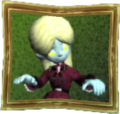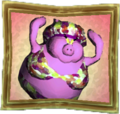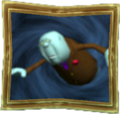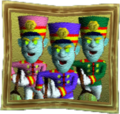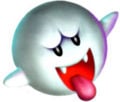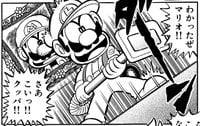Luigi's Mansion
- This article is about the game Luigi's Mansion. For the mansion itself, see Luigi's Mansion (place). For other uses, see Luigi's Mansion (disambiguation).
Template:Infobox Luigi's Mansion is a launch title for the Nintendo GameCube initially released in 2001, and the first installment of the Luigi's Mansion series. It marks the second time where Luigi is the main character, with Mario playing a supporting role, the first being Mario is Missing! A sequel to this game, titled Luigi's Mansion: Dark Moon, was released for Nintendo 3DS family systems in 2013, with a third installment released on the Nintendo Switch on October 31st, 2019. The game marks the debuts of King Boo, Luigi's main antagonist, as well as Professor Elvin Gadd, a major supporting character in the series.
A remake of Luigi's Mansion, developed by GREZZO Co.,Ltd., was released for the Nintendo 3DS in 2018.
Story
Instruction booklet
- And the grand prize is a big, haunted mansion!?
One day, Luigi received an unexpected message: You've won a huge mansion! Naturally, He[sic] got very excited and called his brother, Mario. "Mario? It's me, Luigi. I won myself a big mansion! Meet me there and we'll celebrate, what do you say?"
Luigi tried to follow the map to his new mansion, but the night was dark, and he became hopelessly lost in an eerie forest along the way. Finally, he came upon a gloomy mansion on the edge of the woods. According to the map, this mansion seemed to be the one Luigi was looking for. As soon as Luigi set foot in the mansion, he started to feel nervous. Mario, who should have arrived first, was nowhere to be seen. Not only that, but there were ghosts in the mansion!
Suddenly, a ghost lunged at Luigi! "Mario! Help meee!" That's when a strange old man with a vacuum cleaner on his back appeared out of nowhere! This strange fellow managed to rescue Luigi from the ghosts, then the two of them escaped...
It just so happened that the old man, Professor Elvin Gadd, who lived near the house, was researching his favorite subject, ghosts. Luigi told Professor E. Gadd that his brother Mario was missing, so the Professor decided to give Luigi two inventions that would help him search for his brother.
Luigi's not exactly known for his bravery. Can he get rid of all the prank-loving ghosts and find Mario?
Area 1
Luigi, having won a mansion in a contest he did not enter, arrives in Boo Woods and locates it. He enters the mansion and is soon frightened by a ghost, but Professor E. Gadd appears and attempts to vacuum the ghost with his Poltergust 3000. Though his attempt fails, he introduces himself to Luigi before quickly escorting him to his laboratory near the mansion when more ghosts appear. In the lab, E. Gadd tells Luigi that the house is an illusion that has appeared out of thin air, where Mario has been captured by King Boo and his minions. He gives Luigi the Poltergust 3000 to vacuum up ghosts and the Game Boy Horror to communicate with E. Gadd, scan objects, and see a map of the mansion.
Luigi enters the mansion, sucking up ghosts and finding keys, while meeting Toad along the way, until he encounters a portrait ghost named Neville and defeats him with the Poltergust 3000. He does the same to Lydia, Neville's wife, and fights their baby, Chauncey, who sucks Luigi into his crib and fights him as a giant ghost, but is defeated and sucked into the Poltergust 3000. With his ghost-hunting vacuum filling rapidly, Luigi returns to E. Gadd's lab and empties it, turning Neville, Lydia, and Chauncey back into portraits.
Area 2
Luigi enters Area 2, another area through a previously blocked door and fights more ghosts. After defeating the Floating Whirlindas, he enters the Storage Room and hits a switch, which opens a trapdoor where 50 Boos and their leader, King Boo, are hiding. All of them escape, flying into different rooms of the mansion. Luigi returns to E. Gadd's lab and E. Gadd tells him that the Boos were the ones who released the portrait ghosts. Luigi must capture the Boos to weaken their power, as they are stronger in greater numbers. So Luigi goes through the many rooms of the mansion, vacuuming up any Boos he sees. He also meets Madame Clairvoya, a fortune teller ghost, who tells him to bring her any of Mario's items he finds lying around in the mansion so she can get details on his whereabouts. The items are Mario's Hat, Mario's Glove, Mario's Shoe, Mario's Letter, and Mario's Star. After sucking up Shivers the butler, Melody Pianissima, Mr. Luggs, and Spooky the dog, Luigi enters the Cemetery and fights the shadowy ghost, Bogmire. He defeats him and sucks him into the Poltergust. Afterwards, Luigi returns to E. Gadd's lab once again and empties the Poltergust to turn all the ghosts back into portraits.
Area 3
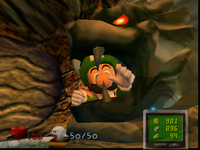
Luigi enters a third area into the courtyard. Down the well, he sees into King Boo's altar and discovers that King Boo has imprisoned Mario in a portrait. Luigi becomes desperate to save his big brother as he reaches out for him. He goes through new rooms of the mansion, finding Mario's items and vacuuming up ghosts, including portrait ghosts Biff Atlas, Miss Petunia, Nana, Slim Bankshot, and the twins Henry and Orville. After Luigi brings Madame Clairvoya all five of Mario's items, she tells him that she sees Bowser in a vision, which is shocking because Mario defeated Bowser and she suspects that King Boo revived him. With her job done, she tells Luigi to suck her into the Poltergust so she can return peacefully to her portrait. After he does so and defeats 20 Boos, he enters the balcony and fights Boolossus, a big Boo made up of fifteen individual Boos, and he lures him into either unicorn statue to split him into his individual Boos and sucks them all into the Poltergust. Then, Luigi returns to E. Gadd's lab once more and empties the Poltergust to turn all the ghosts, including Boolossus, back into portraits.
Area 4
When Luigi enters Area 4 in the attic, the mansion is suddenly struck by lightning, creating a blackout throughout the mansion. He then goes to the breaker room to turn the power back on, but finds it locked. Luigi looks for the key and soon encounters a ghost named Uncle Grimmly and defeats him to get the key. After he turns the power back on, he catches more Boos and portrait ghosts, including the Clockwork Soldiers, Sue Pea, Jarvis, and Sir Weston, before entering the room of Vincent Van Gore, one of the most prominent portrait ghosts who is painting regular ghosts. He sends several waves of ghosts after Luigi, but Luigi defeats them all, causing Van Gore to go into a state of depression and Luigi sucks him into the Poltergust without much resistance. He then goes to the Secret Altar down a creepy hallway in the basement and encounters King Boo, who reveals that he was the one who told Luigi that he won the mansion in a contest and set it up as revenge for all the trouble the Mario brothers had caused him. King Boo goes into Mario's portrait, which turns into a Bowser portrait and sucks Luigi into it. In an arena resembling the roof of the mansion with fire in the background, Luigi fights what appears to be Bowser (as Madame Clairvoya's vision had seen), but when he hits him in the head with an explosive, spiked metal ball, "Bowser" is revealed to be a protective suit worn by King Boo. Luigi defeats King Boo while avoiding the Bowser suit's head and sucks him into the Poltergust 3000.
Luigi returns to E. Gadd's lab one last time and empties the Poltergust to turn all the ghosts, including King Boo, back into portraits. E. Gadd then reverses the Portrificationizer to release Mario from his portrait. After Mario goes through a painful and overwhelming reverse-procedure of all the portrait ghosts captured, he rockets out of the machine, colliding with Luigi, very dizzy and semiconscious afterwards, but otherwise alright. And then, Luigi laughs with tears in his eyes that his brother is safe.
Since King Boo has been defeated, his illusion of the mansion fades away, though the money and jewels Luigi had collected in the mansion were real and with it he gets a new residence, which varies in size depending on the player's rank.
Gameplay
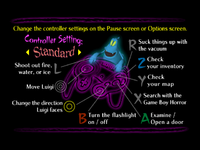
Luigi uses two devices given to him by E. Gadd to progress through the game: the Poltergust 3000 to suck up ghosts and the Game Boy Horror (which is designed to resemble a Game Boy Color) to investigate objects, navigate the mansion and communicate with E. Gadd. On top of its primary function, the Poltergust has various other uses as well, such as sucking up money and being used as a flashlight to help Luigi see and even stun ghosts. Once Luigi collects the corresponding Elemental Medal, he can also use the Poltergust to suck up Elemental Ghosts and expel their fire, water or ice powers to fight other ghosts and deplete their HPs so that Luigi can capture them. In turn, Luigi's own HP is lowered whenever he takes damage and requires him to replenish it by collecting Hearts, or risk a Game Over (at which point he collapses and the words "Good night" appears overhead).
Controls
 - Move (in sidestep mode, the stick does not change Luigi's facing direction)
- Move (in sidestep mode, the stick does not change Luigi's facing direction) - Examine an object / Open a door / Call out for Mario / Reply to E. Gadd
- Examine an object / Open a door / Call out for Mario / Reply to E. Gadd - Turn the flashlight on or off
- Turn the flashlight on or off - Search, using the Game Boy Horror
- Search, using the Game Boy Horror - Check the map
- Check the map - Check the inventory
- Check the inventory - Change direction Luigi faces
- Change direction Luigi faces - Shoot an element
- Shoot an element - Use the Poltergust
- Use the Poltergust
Characters
Ghosts
Common Ghosts
|
|
Portrait Ghosts
In his exploits, Luigi captures up to twenty-three gallery ghosts (five are optional). These ghosts (excluding the third and the final/fourth boss) have 100 HP, but their hearts are not automatically shown like other ghosts: Luigi must find each ghost's weakness before he can suck them up. The following are listed in the rough order they can be caught in the game:
Area One
Neville
The Bookish Father
(Required)Lydia
The Mirror-Gazing Mother
(Required)Chauncey
The Spoiled Baby
(Area Boss)
Area Two
The Floating Whirlindas
The Dancing Couple
(Required)Shivers
The Wandering Butler
(Required)Melody Pianissima
The Beautiful Pianist
(Required)Mr. Luggs
The Glutton
(Optional)Spooky
The Hungry Guard Dog
(Required)Bogmire
The Cemetery Shadow
(Area Boss)
Note: Although Luigi first meets Madame Clairvoya in Area Two, he captures her after he begins Area Three.
Area Three
Biff Atlas
The Bodybuilder
(Optional)Nana
The Scarf Knitting Granny
(Required)Miss Petunia
The Bathing Beauty
(Required)Slim Bankshot
The Lonely Poolshark
(Optional)Henry and Orville
The Twin Brothers
(Required)Madame Clairvoya
The Freaky Fortune Teller
(Required)Boolossus
The Jumbo Ghost
(Area Boss)
Area Four
Uncle Grimmly
Hermit of the Darkness
(Required)Clockwork Soldiers
The Toy Platoon
(Required)Sue Pea
The Dozing Girl
(Optional)Jarvis
The Jar Collector
(Optional)Sir Weston
The Chilly Climber
(Required)Vincent Van Gore
The Starving Artist
(Required)
The Boos
- Main article: List of Boos in Luigi's Mansion
There are 51 (including King Boo) Boos that hide in the various rooms of the mansion. 35 of these are named to differentiate between them, while the remaining 15 make up the third Boss of the game, Boolossus. The magic of the King Boo's spells increase based on the number of his minions nearby. Because of this, Luigi must capture 20 Boos to break the seal designed to block Boolossus from him. After capturing 20 more, the seal separating Luigi from King Boo was broken. If Luigi catches all 50 Boos, he will be rewarded with the extremely valuable Gold Diamond. Each of the Boos' names are puns. For example, "Booigi" is a pun on "Luigi" and "Game Boo" is a nod to the Game Boy.
Other Ghosts
Items
Money
Normal Mansion Total score: 142,390,000 G
| Image | Name | Score | Maximum Count | Maximum Score | Image | Name | Score | Maximum Count | Maximum Score | Image | Name | Score | Maximum Count | Maximum Score |
|---|---|---|---|---|---|---|---|---|---|---|---|---|---|---|
| Gold Coin | 5,000 G | 1536 | 7,680,000 G | Bill | 20,000 G | 1260 | 25,200,000 G | Gold Bar | 100,000 G | 61 | 6,100,000 G | |||
| Blue Sapphires | 500,000 G | 10 | 5,000,000 G | Green Emeralds | 800,000 G | 10 | 8,000,000 G | Red Rubies | 1,000,000 G | 10 | 10,000,000 G | |||
| Blue Diamond | 2,000,000 G | 5 | 10,000,000 G | Red Diamond | 5,000 G | 2 | 10,000 G | Gold Diamond | 20,000,000 G | 2 | 40,000,000 G | |||
| Small Pearl | 50,000 G | 76 | 3,800,000 G | Medium Pearl | 100,000 G | 76 | 7,600,000 G | Big Pearl | 1,000,000 G | 19 | 19,000,000 G |
PAL Hidden Mansion Total score: 186,440,000 G
| Image | Name | Score | Maximum Count | Maximum Score | Image | Name | Score | Maximum Count | Maximum Score | Image | Name | Score | Maximum Count | Maximum Score |
|---|---|---|---|---|---|---|---|---|---|---|---|---|---|---|
| Gold Coin | 5,000 G | 1686 | 8,430,000 G | Bill | 20,000 G | 1425 | 28,500,000 G | Gold Bar | 100,000 G | 76 | 7,600,000 G | |||
| Blue Sapphires | 500,000 G | 5 | 2,500,000 G | Green Emeralds | 800,000 G | 5 | 4,000,000 G | Red Rubies | 1,000,000 G | 5 | 5,000,000 G | |||
| Blue Diamond | 2,000,000 G | 30 | 60,000,000 G | Red Diamond | 5,000 G | 2 | 10,000 G | Gold Diamond | 20,000,000 G | 2 | 40,000,000 G | |||
| Small Pearl | 50,000 G | 76 | 3,800,000 G | Medium Pearl | 100,000 G | 76 | 7,600,000 G | Big Pearl | 1,000,000 G | 19 | 19,000,000 G |
Luigi's NEW Mansion
- Main article: Luigi's NEW Mansion
All of the money and treasure Luigi collects is used to build Luigi's NEW Mansion in place of the old one. The size and general quality of the mansion depends on exactly how much he collects, with the lower ranks featuring smaller mansions and the upper ranks featuring larger mansions. A painting of the mansion Luigi receives then appears at the front of the Gallery, with Luigi's total money on the bottom-left corner. The message reads "Welcome to Luigi's NEW Mansion!" unless Luigi achieves Rank A or H. The requirement to achieve Rank A was increased significantly during localization for PAL regions.
- Rank A: Finish the game at or above 100,000,000G (NTSC) or 150,000,000G (PAL). + Message: Congratulations! Your mansion is complete!
- Rank B: Finish the game with 70,000,000 to 99,999,999G (NTSC) or 70,000,000 to 149,999,999G (PAL).
- Rank C: Finish the game with 60,000,000 to 69,999,999G.
- Rank D: Finish the game with 50,000,000 to 59,999,999G.
- Rank E: Finish the game with 40,000,000 to 49,999,999G.
- Rank F: Finish the game with 20,000,000 to 39,999,999G.
- Rank G: Finish the game with 5,000,000 to 19,999,999G.
- Rank H: Finish the game with 5,000 to 4,999,999G. + Message: The haunted mansion disappeared without a trace...
- The Rank A Mansion appears at the side of Luigi Circuit in Mario Kart: Double Dash!! However, Rank D is shown in the opening of the sequel, Luigi's Mansion: Dark Moon.
Mario's items
Luigi may find several items that Mario has dropped in the mansion. Once he has received one, he can show it to Madame Clairvoya for information of Mario's whereabouts.
| Item | Location | Text |
|---|---|---|
Mario's Hat |
Laundry Room | You found Mario's Hat! And it's been laundered recently! |
Mario's Letter |
Courtyard | You found Mario's Letter! I wonder what it says... |
Mario's Shoe |
The Twins' Room | You found Mario's Shoe! It smells...like Mario's feet. |
Mario's Glove |
Projection Room | You found Mario's Glove! Eew... It's a little sweaty. |
Mario's Star |
Observatory | You found Mario's Star! My, what a glittering beauty! |
Miscellaneous items
Professor E. Gadd's Gallery
Professor E. Gadd had trapped the Portrait Ghosts into paintings during his past ghost adventures and put them for display in his personal gallery - until King Boo released each of them. As Luigi recaptures gallery ghosts, they will be framed in three colors: bronze, silver, or gold. The frame color of non-boss ghosts depends on how much HP Luigi sucks in one go, which produce pearls:
- Bronze. Only small pearls, which Luigi earns one of for every 10 HP sucked in one go. The portraits show the ghosts in poor quality.
- Silver. At least one medium pearl, which the ghost gives up for every 50 HP sucked and every 10 after. So for 60, 70 and 80 HP in one go, Luigi earns another medium pearl. The portraits show the ghosts in better quality.
- Gold. The only big pearl possible is given up if Luigi can suck 90 HP in one go. The portraits of the ghosts are often just what they looked like when Luigi captured them.
If Luigi sucks all 100 HP at once, no extra pearl is awarded. The maximum amount of money to be gained per Portrait Ghost is 1,600,000G: 4 small pearls, 4 medium pearls and 1 big pearl.
Boss gallery ghosts' (Chauncey, Bogmire, Boolossus, and King Boo) frames and quality are determined by how high Luigi's health is after capturing the ghost.
- Bronze. If Luigi fails to keep his health above 60 HP, he will get this painting.
- Silver. To get this portrait, Luigi's health must be kept above 60 HP at the end of the battle.
- Gold. To obtain this high-quality painting, his health must not have declined below 90 HP at the end of the battle.
Hidden Mansion
Once the player beats the game for the first time, the quest can be restarted in the normal mansion or the "Hidden Mansion". In the Japanese and North American versions of Luigi's Mansion, the Hidden Mansion differs from the normal mansion in only two ways:
- Luigi takes twice as much damage when hurt.
- The Poltergust 3000 is 1.5× stronger. In addition to improving its reliability in regard to capturing ghosts, this helps improve Luigi's chance of earning larger pearls, and thus acquire nicer frames for the Portrait Ghosts.
Additional changes were made to the Hidden Mansion featured in the European and Australian versions of Luigi's Mansion, listed as follows:
- The PAL Hidden Mansion is mirrored from left to right when compared to the Normal Mansion. The NTSC version keeps the layout the same.
- There are more normal ghosts around the mansion; for example, in The Artist's Studio, Luigi must fight five of each ghost instead of three. More powerful ghosts are also encountered earlier than in the Normal Mansion.
- Bosses are more difficult, such as having different attacks. Chauncey's rocking horses, for example, are much bigger and swerve left to right, instead of going straight. Another example is the Boolossus battle, in which the player rides around on the Poltergust 3000 while trying to pop Boolossus, which makes movement more slippery.
- Rooms and hallways are much darker when compared to the Normal Mansion, almost pitch black when the lights are off.
- Boos are usually more agile and difficult to catch. Most of them have more HP, although some have the same, and some have less. The ones with less HP are often much faster and can leave a room in seconds.
- Fewer hearts are available. Locations that have hearts in the Normal Mansion do not have them. Hearts that heal 50 HP exist in the Courtyard by vacuuming the Slim Bankshot-like statue, and rarely in the Foyer when checking the drawer.
- Speedy Spirits and Gold Mice always drop a Blue Diamond when caught, raising the maximum possible amount of money from 142,390,000G to 186,440,000G.[1] Because the amount of money required for an A rank was increased to 150,000,000G (instead of 100,000,000G in the NTSC version), this means the Hidden Mansion is necessary to play through in order to get an A rank.
- Instead of 40 Boos, 45 are required to fight the final boss.
Gallery
- For this subject's image gallery, see Gallery:Luigi's Mansion.
A Boo
Professor E. Gadd with the Poltergust 3000.
Some of the different kinds of Ghosts (with Biff Atlas in the center) found in the game
Media
Quotes
- Main article: List of Luigi's Mansion quotes
Luigi
- "Hello?"
- "MARIO!/MARIOOO?/Mario?/M-M-M-M-Mario?"
- "Way to go, genius. Got the hang of that thing yet?"
- "What a dreadful picture... But that candle next to it might be important..."
- "I'm willing to bet there's something cold in here."
- "I always preferred the bottom bunk..."
- "Well, at least we won't have a shortage of toilet paper..."
- "Now that's just not my style."
- "You know... I never noticed how cute those red polka dots look on top!"
- "It's a picture...but I wouldn't call it art."
- "You know, I never noticed how lovely those red polka dots look on top!"
- "This looks quite old... I wonder how much it would sell for."
- "Looks ordinary... A little TOO ordinary."
- "I wonder why only this one's frozen..."
- "I bet I'd look pretty tough wearing one of these..."
- "One really shouldn't open this kind of thing without asking..."
- "Nothing unusual here... Boring!"
- "I don't think I can reach that directly..."
- "Boy, those Boos sure did make a realistic fake mansion..."
- "Now that I look at it-- it's full of moth holes! Yecch!"
- "So much dust! This will never pass the white-glove test!"
- "Well, they sure did pile odds and ends everywhere... Filthy."
- "I should probably give that a quick vacuuming..."
- "Oh, what's this?! Just how I like it... Nice and clean!"
- "Well, I sure can't read that from here..."
- "I wonder how old this is..."
- "Do Boos wash their faces?"
- "I've been wanting one of these for quite a while..."
- "Oh, wow... I've always wanted one of these!"
- "What kind of picture is this?"
- "I really have no use for this..."
- "Not particularly interesting..."
- "Hmmm... Weird..."
- "Awww, poor thing..."
- "How could anyone treat an animal that way? I won't stand for it!!"
- "Oh, what's this?! This would sure fetch a pretty penny..."
- "Looks like something might be in there..."
- "Now, that's a classic. I wonder how much it would sell for."
- "If you look closely, you can tell it's really just a photograph!"
- "This looks like it might break if I sit on it..."
- "Man, I'm tired... That bed sure looks comfy."
- "I could just curl up there and sleep until dawn..."
- "Now who is this supposed to be?"
- "Was someone trying to show off or what?"
- "What's this?! Looks fancy!"
- "WAHAHA! Who designed this?!"
- "There's something fishy here..."
- "I really should work out more. Maybe I ought to throw a few quick jabs while I'm here..."
- "I'm not so interested in bikes..."
- "I've always been a good runner..."
- "I don't care much for pointy objects..."
- "It looks old, but I bet it still has a nice tone..."
- "Hmm. Should I play it?"
- "I never could play the piano..."
- "Looks like a fun place to make shadow puppets..."
- "Looks like this hasn't gotten much use of late..."
- "What's this, an antique?"
- "Wouldn't it be nice if I could raise carrier pigeons here?"
- "What in the world is this?"
- "This is the kind of thing I would put in the bathroom..."
- "Fabulous!"
- "Exquisite..."
Mario
- "Get me outta here!"
- "'Ey, Luigi, what's the hold-up?"
Professor E. Gadd
- "I'm getting too old for this ghost-catching tomfoolery."
- "I swear, this house seems to have more and more ghosts every day!"
- "Alright, youngster! Look lively! Follow me, posthaste!"
King Boo
- "I don't plan to give up my favorite decoration. I like Mario where he is."
- "This Mario painting looks lonely... I must have a Luigi painting as well! Then my gallery will truly be complete! Bleah HA HA!"
- "I am not afraid of you, fool! I fear only that infernal Poltergust 3000 you carry on your back! Stupid machine!"
Development
The idea for Luigi's Mansion was first centered around exploration many different rooms, similar to The Legend of Zelda's dungeons. Mario was initially chosen as the protagonist. The team wanted the location to be a huge house from the start, and it began as a "Japanese-style Ninja house." After some playtests, the setting was retooled to resemble a dollhouse, as the player would always be looking through one of the walls to see the rest of the room. As the lighting scheme was developed, the team focused on darkness and shadows, which turned the dollhouse into an "American-style haunted mansion." With the change in setting and the new emphasis on ghosts, Luigi was chosen to be the new protagonist, as the team wanted a cowardly character as Mario was more known for being brave. The Portrait Ghosts were created in order to distinguish them from the rest of the Mario series' ghosts, namely Boos. The team also considered using no characters at all from the rest of the Mario series besides Luigi and Mario to establish the game as not just "another chapter in the Mario series," though they eventually resolved to use the series' characters sparingly.[2]
As development for Luigi's Mansion took place alongside the Nintendo GameCube's development, the team was able to make recommendations for increasing the console's capabilities. Among those requests was dynamic lighting, something that team chiefly wanted, which was eventually added to the graphics chip. Working with the Nintendo GameCube instead of the Nintendo 64 saved a lot of time that might have otherwise been spent overcoming the latter console's technical hurdles. The game had also started development before the Nintendo GameCube's console was designed, though the team wanted to use two analog sticks from the start and base the controls largely around the sticks, generally simplifying the controls. Once the controller was finalized and put into use, many of the game's testers commented on how the C Stick was uncomfortable to use for a long time, causing a redesign that made it wider and more comfortable for thumbs.[2]
The game's elements, fire, water, and ice, came as a result of the team wanting to "display fire water, and atmospheric effects realistically." Early on, dust clouds used a fixed animation every time the dust was interacted with and the team wanted to make it more interesting through dynamic interactions. One programmer worked on the dust for six months. Another effect that the team handled was the "stretch" effects produced by the ghosts when being vacuumed and a lot of work was spent making sure it functioned properly. Motion capture was used in the game's intro (notably while Luigi is walking in a "very cowardly way") and ending.[2]
A lot of time was spent discussing how difficult the team wanted the game to be. This led to work on a control scheme that only used a single analog stick, which was eventually scrapped, though it led to the "Standard" control scheme being added with the "Sidestep" control scheme. This also led to keys automatically showing which door they opened on the map and the team felt that players would be frustrated otherwise. Eventually, the team concluded that they wanted the difficulty to be well-balanced, which was important for a launch title. In a similar vein to Yoshi's Story, they wanted the game to only need a few hours to beat, but also make the player feel motivated to replay it again. This philosophy led to an emphasis on puzzle elements and not item collection and the ability to ignore certain elements of the game.[2]
The game's schedule was tight; there were several arguments between the designers and the programmers over which features might not be implemented, but by the end of development, more ideas were being added and not many features were removed. The ability to turn off the flashlight was among those late features, after a suggestion by Shigeru Miyamoto to let the players do more with the other buttons. Miyamoto also suggested that Luigi immediately tap the wall when pressing ![]() instead of going through a long animation. Luigi's whistling and humming, as well as his ability to call for Mario, were all added late into the game's cycle as well. The humming came about after the team decided that background music would be uninteresting and Luigi's call came about after a staff member suggested it to reinforce Luigi's goal of finding Mario. The team intended for their end result to not be scary for the players; the team wanted to create something innovative that functioned well just from a technical standpoint. They spent time creating a unique style to the game and not worrying about how it matched up to other games, as their game is "different, unique."[2]
instead of going through a long animation. Luigi's whistling and humming, as well as his ability to call for Mario, were all added late into the game's cycle as well. The humming came about after the team decided that background music would be uninteresting and Luigi's call came about after a staff member suggested it to reinforce Luigi's goal of finding Mario. The team intended for their end result to not be scary for the players; the team wanted to create something innovative that functioned well just from a technical standpoint. They spent time creating a unique style to the game and not worrying about how it matched up to other games, as their game is "different, unique."[2]
Pre-release and unused content
- Main article: List of Luigi's Mansion pre-release and unused content
Concepts for Luigi's Mansion, such as character designs, were being planned during the Nintendo 64's lifetime. Many rooms had different names in one or more early builds; for example, the Foyer was originally called the "Entrance". The Poltergust 3000 used to have a pressure meter and, if it overheated, the Poltergust 3000 would ignite and injure Luigi.[3] The Poltergust's shape is also more rectangular in one or more early versions.
Staff
- Main article: List of Luigi's Mansion staff
The original game's producers were Shigeru Miyamoto and Takashi Tezuka, and the director of the game was Hideki Konno. The music was composed by Kazumi Totaka and Shinobu Tanaka.
Other media
Luigi's Mansion appears in volume 26 and 29 of Super Mario-Kun. In volume 26, which usually follows the story of Paper Mario, the Luigi's Mansion section is condensed into one chapter. The story begins similarly to the game: Luigi wins a mansion. He tries calling Mario's name, but Mario is absent. Luigi then treks to the mansion by himself. After a walk through the forest at night, Luigi is horrified to see his mansion. There, he meets a harmless Boo (案内役 テレサ) that leads him into the mansion. Inside the mansion, he and the Boo find a vacuum, so he tests it on the Boo, much to the Boo's anger. Luigi proceeds to vacuum the ghosts and he even encounters a Ghost Guy, which he doodles on its face.
Luigi then finds Mario trapped in a painting. Luigi is then ambushed by Bowser. Luigi attempts to run behind Bowser, but Bowser twists his head and burns Luigi. While Bowser throws a spike ball, Luigi uses his vacuum to deflect it at him, knocking off the head. King Boo flies out and Luigi proceeds to suck in King Boo, breaking the spell and freeing Mario. The Bowser head, still flying, lands on Luigi's head and Mario, mistaking him for Bowser, fights him. Once Mario realizes his mistake, he immediately regrets what he's done and the Boo watches them. Despite the chapters being seemingly disjointed, Luigi later joins Mario during a fight with Huff N. Puff and uses a new Poltergust to vacuum the Tuff Puffs.
Not much is known in the segment in volume 29, but Toad travels along with Luigi.
References to other games
- Mario Bros. and Super Mario World: Both games were mentioned during Melody's quiz.
- Super Mario Bros.: One of the songs that Melody plays on her piano is a rearrangement of the underwater stage theme. Also, the Luigi sprite shown on the Game Boy Horror is a sprite from the Super Mario All-Stars version of the game. The game's aboveground stage theme is played if Luigi checks all instruments in the Conservatory and the underground theme is played during a part of the credits. The mysterious "Bowser" manned by King Boo may also be loosely based on the fake Bowsers from this game in castles 1 through 7.
- Super Mario Bros. 3: One of the other songs played on Melody's piano is a rearrangement of the grass stage theme.
- Wario Land: Super Mario Land 3: Luigi's new mansion at the end of the game depends on the score the player has, similar to how Wario's abode will end up better with a higher score.
- Super Mario 64: When Luigi is talking to Toad, an arrangement of the theme heard when talking to Toads in Super Mario 64 is played. The sound effect for collecting a Power Star plays when one of Mario's items is collected. Several other sound effects were taken from this game as well.
- Mario Golf: Template:Media link for this game is an altered and sepia recoloring of Mario Golf's Template:Media link.
- Mario Tennis: Some of Toad's voice clips were reused from this game.
- Paper Mario: Although this reference was lost during translation, one of Neville's books (in the Japanese version) is titled "Mario Story" which is both Paper Mario's Japanese title and the title of the book Herringway wrote about the game's story (also in the Japanese version).
- Animal Crossing: Professor Elvin Gadd's vocalizations were inspired by the animal speech from the Animal Crossing series.
References in later games
- Super Smash Bros. Melee: A Luigi's Mansion trophy appears in this game, which depicts Luigi using the Poltergust 3000.
- Super Mario Sunshine: One of the game's bosses is named King Boo in the English version, though the character is otherwise unrelated to the antagonist from Luigi's Mansion. Professor E. Gadd is said to have invented F.L.U.D.D. and Bowser Jr.'s magic brush and is mentioned by Bowser Jr. as "a strange old man in a white coat". A Pianta cleaning the ducts of Hotel Delfino in the episode 'Mysterious Hotel Delfino' at Sirena Beach wishes that someone would suck up the ghosts in the hotel with a vacuum, as a reference to the Poltergust 3000.
- Mario Party 4: The Gaddlight is an item in the game used to repel Boos and keep them from stealing coins or stars.
- Mario Kart: Double Dash!!: Luigi's Mansion appears as an unlockable battle stage in this game. Several of the Portrait Ghosts appear in the main area, including King Boo's gold frame. Luigi's Rank A Mansion appears in the background of Luigi Circuit.
- Wario World: The ending conditions to restoring Wario's Castle are similar to those of the endings in this game.
- Mario & Luigi: Superstar Saga: Professor E. Gadd makes a cameo appearance and Luigi occasionally takes out the Poltergust 3000. A few of the ghosts appear in the Starbeans Café and are vacuumed by E. Gadd, while the Luigi's Mansion theme plays.
- Paper Mario: The Thousand-Year Door: When Luigi appears in the audience, he occasionally has the Poltergust 3000 on his back. It does not affect anything in-game, though.
- Mario Power Tennis: Luigi's Mansion is also a playable tennis court that has the ghosts rising from their graves trying to distract the players. Luigi uses the Poltergust 3000 for his defense shot.
- Super Mario 64 DS: King Boo appears as a boss in this game, capturing Luigi after vowing to catch him in Luigi's Mansion. After he was defeated by Mario, Luigi can be unlocked, which is the opposite of what happened in Luigi's Mansion. There is a minigame in the Rec Room based on Luigi's Mansion called Hide and Boo Seek, where Luigi has to find a certain amount of Boos in the darkness by scribbling out the black to reveal them. Some of Luigi's voice clips were reused in this game.
- Mario Kart DS: Luigi's Mansion appears as a race course in this game. The Poltergust 4000 (based on the Poltergust 3000) was Luigi's first character-specific kart.
- Mario & Luigi: Partners in Time: Professor E. Gadd appears again and has a more major role than in the previous Mario & Luigi game. When the Mario Bros. travel into the past, they meet the younger E. Gadd whose lab is destroyed by a volcanic eruption and he says he will set up a new lab in Boo Woods, foreshadowing Luigi's Mansion. In most scenes with Professor E. Gadd, an arrangement of the Luigi's Mansion theme can be heard.
- Mario Hoops 3-on-3: Luigi's Mansion appears as a basketball court, where the ghosts from Luigi's Mansion fly around trying to grab the basketball.
- Super Paper Mario: The main foyer of the mansion appears to be the location of the Mansion Patrol arcade game.
- Mario Party 8: The ghosts from Luigi's Mansion re-appear in the minigame (which may be somewhat based on Luigi's Mansion) Specter Inspector.
- Super Mario Galaxy: Luigi appears in the Ghostly Galaxy after being kidnapped by the ghost Bouldergeist and Mario must save his brother. This is the exact opposite of what happens in Luigi's Mansion.
- Super Smash Bros. Brawl: Luigi's Mansion appears as an unlockable stage and trophy in this game. The Luigi's Mansion main theme is one of the selectable music themes for this stage. In the "King Dedede steals Peach" and "King Dedede steals Zelda" cutscenes of the Subspace Emissary (where Luigi is introduced), a different arrangement of the Luigi's Mansion theme plays.[4]
- Mario Super Sluggers: Luigi's Mansion is a playable baseball park.
- Mario Sports Mix: Luigi's Mansion makes an appearance as a basketball court and a volleyball court. He also uses his Poltergust 3000 whenever he uses his special shots.
- Mario Kart 7: Luigi's Mansion from Mario Kart DS returns as a retro stage.
- Mario Party 9: In Boo's Horror Castle, there are painting references of Garbage Can Ghosts and Vincent Van Gore. Some of the rooms of the mansion are also referenced.
- Mario & Luigi: Dream Team: One of the messages floating in Luigi's Dream's Deep says "I fight ghosts!", a reference to this game.
- Super Smash Bros. for Wii U: Luigi's Mansion remains unchanged as the stage from Super Smash Bros. Brawl.
- Mario Kart 8: Luigi's Mansion can be seen in the background of Baby Park.
- Mario Kart 8 Deluxe: Luigi's Mansion from Mario Kart: Double Dash!! returns as a retro battle course.
- Mario + Rabbids Kingdom Battle: Luigi's weapons are modeled after vacuum cleaners, in reference to the Poltergust 3000. Additionally, several of Luigi's voice clips from this game are reused.
- Super Smash Bros. Ultimate: Luigi's Mansion once again returns as a stage, with the layout unchanged. Simon and Richter Belmont's debut trailer has Luigi traversing Dracula's Castle with his Poltergust and being extremely terrified of his surroundings before being killed by Death, a clear allusion to Luigi's role in the game and to a lesser extent its sequels. Dracula being the final boss of Luigi's Classic Mode is most likely a reference to his role in the franchise as a whole.
- Luigi's Mansion 3: Aside from it being one of the game's sequels, the ending has the main location's status varying depending on how much G the player collected, similar to Luigi's NEW Mansion in this game.
Reception
The game has received mostly positive reviews. Gamespot gave the game a 7.9/10, saying that it featured creative and refreshing ideas, but it strays too far from the Mario series.[5] IGN also gave it a positive review, giving it a 7/10, praising its graphics, sounds, and gameplay, but heavily panning the lack of any replay value.[6] Nintendo Life gave it an 8/10, claiming it's a well-crafted game, but criticized how short the length of the game was.[7] The game was mainly praised for its clever features and for giving Luigi a starring role. However, it was criticized for its short length.
| Reviews | |||
|---|---|---|---|
| Release | Reviewer, Publication | Score | Comment |
| Nintendo GameCube | Matt Casamassina, IGN |
7/10 | Luigi's Mansion is fun while it lasts, it really is. The control is top notch, the puzzle solving elements mildly enjoyable, and the house a big, unexplored thing overflowing with spirits. The technology powering the game is phenomenal, you won't find better lighting and shadow effects, not to mention cloth physics, in any other game for a good while to come...The problem is that the game doesn't really offer much in the vein of variety. Exploring room after room and hallway after hallway only to suck up ghost after ghost becomes redundant. And the adventure ends abruptly five or six hours after it's started...This may be Nintendo's internal flagship launch title, but it's certainly not the GameCube equivalent of Mario 64, as many of us were hoping for. |
| Nintendo GameCube | Shane Satterfield, GameSpot |
7.9/10 | Luigi's first solo excursion has flashes of brilliance and is fun while it lasts, but the short amount of time it takes to complete it makes it a hard recommendation. There is some incentive to play through the game a second time, but even that can be done within an average rental period. If you're a serious video game collector or just want a game that will adequately show off your new console, Luigi's Mansion is worth picking up. But for everyone else, a trip to the local rental shop should suffice. |
| Nintendo GameCube | Tom "Mugwum" Bramwell, Eurogamer |
7/10 | Luigi’s Mansion is a delightful little game, instantly appealing to anybody with more than a passing interest in its heritage, but it isn’t the GameCube equivalent of those platform classics I name-checked at the start of the review. A competent, atmospheric adventure and truly a new direction for the characters, but at this length it simply isn’t worth the £35, let alone the cost of the console. If Miyamoto’s vision of shorter games more often is to become reality, then the pricing structure will need serious adjustment. |
| Nintendo GameCube | Jacob Crites, Nintendo Life |
8/10 | What Luigi's Mansion lacks in content and longevity, it makes up for with a remarkably well-crafted and unique single campaign that will keep you consistently entertained from front to back. It's not quite on the same level as Mario's better outings, but the game is so entirely different from anything Mario has ever starred in that it feels almost unjust to compare them; and, really, it's this complete departure from the Mario formula that makes the game so successful in the first place. The gameplay design is so uncommon that it's pretty difficult to slap a genre label on it, but suffice to say that if you consider yourself a gamer, you owe it to yourself to give this one a shot. |
| Aggregators | |||
| Compiler | Template:Nowrap | ||
| Metacritic | 78 | ||
| GameRankings | 79.16% | ||
Awards
Luigi's Mansion won the BAFTA Interactive Entertainment Award for audio in 2002.[8]
Sales
Luigi's Mansion is the 5th best selling game for the Nintendo GameCube, having sold approximately 3.6 million copies, including 2.19 million in the US, 460,000 copies in Japan and 100,000 units in the UK, as of December 31, 2009.[citation needed]
Names in other languages
| Language | Name | Meaning | Notes |
|---|---|---|---|
| Japanese | ルイージマンション[?] Ruīji Manshon |
Luigi Mansion |
Trivia
- The box art resembles the cover photo of the 1990 Christmas film Home Alone.
- A mistake on page 30 of the American and Australian editions of the Luigi's Mansion instruction booklet shows Professor E. Gadd speaking in Japanese.
- Totaka's theme can be heard by going to the Training Room and waiting at the tutorial screen (the one where Luigi learns how to use the Poltergust 3000) for 3 minutes and 15 seconds.
- This was the last entry in the Mario franchise to be produced under Hiroshi Yamauchi's administration as president of Nintendo.
- This is one of the two GameCube games to use N64 style artwork and renders, with the other one being Super Smash Bros Melee.
References
- ^ Luigi’s Mansion – PAL: mansion value [dead link]
- ^ a b c d e Sinfield, George. Luigi's Mansion Official Nintendo Player's Guide, pages 88-93. "Developer Interview" with team members Hideki Konno, Tadashi Sugiyama, and Hiroki Sotoike.
- ^ https://www.youtube.com/watch?v=gK0tqxyYlXk&t=500
- ^ Gamechamp3000 (April 26, 2008). (Super Smash Bros. Brawl) SSE #27z) King Dedede Steals Peach. YouTube. Retrieved December 13, 2014.
- ^ [1]
- ^ [2]
- ^ [3]
- ^ Interactive in 2002. BAFTA. Retrieved July 11, 2018.
External links
- Japanese website
- European (UK) microsite [dead link]
- North American website (Internet Archive: Wayback Machine)















